by Whitney Cherry | Aug 28, 2015
 Research shows that 20-40% of children are bullied in some way. Whether bullying is verbal, physical, or done online it is a very real problem that can happen in any school, even among young school-age children. A safe and secure environment is key for the Essential Element of Belonging, one of the foundations of 4-H positive youth development. Being educated about what bullying is, knowing how to spot the signs of bullying, and learning what to do if your child is affected by this behavior can help parents address bullying if and when it happens.
Research shows that 20-40% of children are bullied in some way. Whether bullying is verbal, physical, or done online it is a very real problem that can happen in any school, even among young school-age children. A safe and secure environment is key for the Essential Element of Belonging, one of the foundations of 4-H positive youth development. Being educated about what bullying is, knowing how to spot the signs of bullying, and learning what to do if your child is affected by this behavior can help parents address bullying if and when it happens.
How to recognize bullying- Bullying can take several forms. It can be observable or secretive behavior.
| Observable Behavior: |
Secretive Behavior: |
- Intimidation and threats.
- Name calling, insults, and comments about disability, gender, and race.
- Teasing about personal characteristics or sexual harassment.
- Physical assault, tripping, hitting, pinching and other physical abuse.
- Destruction of property, demanding money or other possessions.
|
- Rejecting, excluding, and isolating victims from others.
- Spreading rumors and other public humiliation.
- Manipulating friends and relationships, passive aggression.
- Passing damaging notes or posting threatening or damaging emails or web material.
- Blackmailing, harassment, and dangerous dares.
|
Left unaddressed, bullying can cause depression and lasting psychological damage to the victim. It can result in poor attendance or psychosomatic illnesses. Violence can escalate into serious property damage, and injuries to students and adults. Bullying at school also affects others who are not involved directly but who simply witness or are aware of mistreatment of another student. These students may suffer from fear and concern about their schoolmate who is targeted. They may feel guilt but also may fear the bully so much that they do nothing to help. Worse, they may become offenders themselves because they fear the perpetrator will target them.
Bullies tend to seek out victims who:
- Are unable to defend themselves.
- Have little social support, or few friends.
- Are not involved in extra-curricular activities.
- Are low achievers in academics or sports.
- Are not popular or focused on by adults in the school.
- Have less developed social skills.
- Have difficulty communicating.
- Have low-self esteem or are unassertive.
Know the warning signs of bullying- It is not uncommon for a child who may be the victim of school bullying to be reluctant to tell his or her parents out of shame or fear. Children fear that the adults will not be able to help them or that they may make the situation worse. They may also believe the bully will retaliate against them or their friends. If you suspect that your child may be a target of school bullying, look for these signs:
- Sadness, anxiety, difficulty sleeping or eating, temper or emotional outbursts, picking on younger siblings.
- Unexplained bruises, cuts, or damaged clothing or school supplies.
- Fear of school, not wanting to go to school, or sudden drop in school performance.
- Dislike of recess and avoidance of unsupervised school areas such as the bathroom, despite the need to go.
- Withdrawal from friends and family, fear of parent communication with teachers.
- Complaints of physical problems without a medical reason.
- Any abrupt behavior change or sudden lack of self-esteem.
What Parents Can Do to Prevent and Stop Bullying –Parents are the key to preventing and stopping bullying. Here are a few ways that parents can help respond to bullying.
Stay connected with your child. The more you know about your child’s friends and their interactions with classmates and peers, the more likely you are to spot any changes in their social circle. Talk with your child every day about specifics at school and extracurricular activities such as what the best or worst part of their day was. This is also an important way to establish good communication with your child so that they can come to you when they have a problem.
Explain to your child what bullying is. Children understand that hitting or pushing another child is wrong, but you can also explain that other forms of bullying, such as excluding or ignoring someone, can also be hurtful.
Tell children what to do in case they experience or witnesses bullying. Talk with your child about the basics of what to do if they encounter hurtful behavior directed toward them or someone else. Tell your child to alert a teacher right away if they see or are subject to bullying behavior, and that it is important to stop someone from getting hurt.
Teach a child the importance of empathy. Research has shown that emotional intelligence and empathy skills may be even more important for success in life than intellectual intelligence. A child who is able to understand what it may feel like to be bullied and can understand and regulate their own emotions is less likely to engage in that kind of behavior.
Set a good example. Do you ever make fun of other people or gossip about others in front of your child? Have you ever spoken rudely to a waiter at a restaurant or to a store clerk in a shop? Even if you think your children are not listening or observing your behavior, the fact is that kids learn a lot about how to conduct themselves from watching their parents.
Talk to your school about what programs are being used to deter bullying. If you suspect that your child may be the victim of school bullying, talk to your child’s teacher about your concerns. Ask the teacher to watch out for problems and notify the school principal and counselor about your concerns as well.
As parents and volunteers, it’s our job to provide youth with a safe environment where they can learn and grow. For more resources about bullying, contact your local UF IFAS Extension Office, or download some of our other resources:
Talking About Bullying
Bullying and Children with Disabilities
Bullying Related to Lack of Time with Dad
Cyberbullying
Outcomes of Bullying
Parent’s Role in Bullying Behavior
Teens and Sexual Harassment: Making a Difference
by Stefanie Prevatt | May 29, 2015
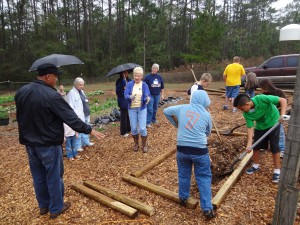
Photo credit: Zulema Wibmer, 4-H Program Assistant, Leon County 4-H Office
Garden-based education is taking America by storm. While this is concept dates as far back as the seventeenth century, it certainly feels like the popular movement of the day. 4-H has been using garden based education since 1902 with tomato and corn clubs to teach life skills such as resiliency, planning and organizing, and communication. These same skills are necessary to become a successful entrepreneur:
Resiliency: the ability to try again after failure. A garden is the perfect place for youth to test ideas or try new things. As adults, we know that sometimes the key to success is (safe) failure! If you are using a garden your classroom, allow creative experimentation. Success will build on itself and trials that missed the mark will make for more lively discussion and group cohesion.
Planning/organizing: the process of figuring out what to do (planning) and how to do it (organizing). Whether you are starting new or continuing an existing project, allowing the expression of youth ideas and goals – followed by their help implementing these plans – is crucial to your project’s success. Remember, we can grow all the vegetables in the world, but if the youth don’t learn or feel a sense of accomplishment related to the project, all we did was grow vegetables.
Communication: the exchange of thoughts, messages, or information, as by speech, signals, writing, or behavior. In today’s tech savy world, we are losing the ability to communicate in person and in writing. You have a unique opportunity to work with your group together, or as individuals, to discuss (or write descriptively) about your garden.
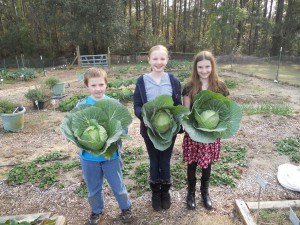
Photo credit: Zulema Wibmer, 4-H Program Assistant, Leon County 4-H Office
UF IFAS Extension offers many resources to help both youth and adults become entrepreneurs in the food industry. Food entrepreneurship has really exploded with the Cottage Food Law. Many County Extension Offices offer workshops and seminars on food entrepreneurship, and there are also some great online resources to help you get started:
If you have a green thumb, consider going “totally green” as a 4-H gardening volunteer or Master Gardener. 4-H needs caring adults like you to share their knowledge and passion for gardening with the next generation. Through the 4-H gardening project, youth not only learn gardening knowledge and skills, they also learn responsibility, teamwork, and other life skills that will help them grow up to be compassionate and competent citizens. To get involved, contact your local UF IFAS Extension Office, or visit http://florida4h.org./volunteers.
Your opinion matters! Please provide feedback on this short survey to help us improve our blog: https://ufl.qualtrics.com/SE/?SID=SV_3gtLKjqia3F75QN
by Whitney Cherry | May 8, 2015
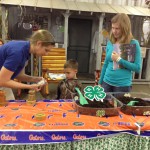
Photo Credit: Whitney Cherry, UF IFAS Extension
4-H literally got its roots in gardening (pardon the pun). The very first 4-H Clubs focused on growing tomatoes and corn, and many youth and volunteers still enjoy gardening projects today. Gardening enriches your life, promotes good health, and saves money. One way to save money is to make your own paper pots to start your seeds. They are fun and inexpensive to make and are a perfect activity for your next club meeting! For beginners, we recommend growing tomatoes, peppers, eggplant, okra, beans, basil, chives, parsley, and lettuce. Not into vegies? Try starting sunflowers, zinnias, pansies, or petunias instead.
Items you will need:
- Newspaper strips (not glossy inserts)
- Bottle (not glass) or can to wrap paper around
- Seeds and Soil
What to do:
- Cut strips of newspaper about 4” wide.
- Wrap strip of newspaper around an empty juice bottle and roll; try to keep the paper wrapped tightly. Half of the strip of paper should overlap the open end of the bottle.
- Fold the ends of the paper against the bottom of the bottle.
- Push the bottom of the bottle against a flat, hard surface (such as a table) to seal the bottom of your pot.
- Pull the bottle out and you have a finished paper pot. Fill with soil an plant your seeds.
- When the seedling is ready to transplant, simply drop the entire pot into the ground. The newspaper will biodegrade in your garden, and your plant will never be uprooted. Make sure paper is not sticking out of the ground – it will wick water away from the plant if not underground.
You can print a PDF version of the instructions for this activity. Other great gardening resources include:
If you have a green thumb, consider going “totally green” as a 4-H gardening volunteer! 4-H needs caring adults like you to share their knowledge and passion for gardening with the next generation. Through the 4-H gardening project, youth not only learn gardening knowledge and skills, they also learn responsibility, teamwork, and other life skills that will help them grow up to be compassionate and competent citizens. To get involved, contact your local UF IFAS Extension Office, or visit http://florida4h.org./volunteers.
Your opinion matters! Please provide feedback on this short survey to help us improve our blog: https://ufl.qualtrics.com/SE/?SID=SV_3gtLKjqia3F75QN.
by pmdavis | Apr 3, 2015

Dying eggs with natural materials is a fun 4-H club activity that teaches a little science too!
This time of year, many children are egg-cited to dye Easter Eggs! This year, instead of buying a kit to dye eggs, why not use natural materials that you most likely already have in your kitchen or yard? One 4-H Junior Master Gardener Project teaches young gardeners how to make dyes made from plant parts and other natural materials and teach a little science at the same time.
Start by cleaning the eggs by wiping them with vinegar. Why vinegar? Well there is a little science behind that…and a great teachable moment! The shell is protected by a thin layer of protein molecules called the cuticle. This cuticle has a neutral charge so not much is attracted to it. The vinegar contains acetic acid, which reacts to make the cuticle positively charged. The dye typically has a negative charge. So to get the dye to “stick” to the egg, the positive charge on the cuticle attracts the negative charge of the dye. (Use a magnet as a visual example.) Therefore the acid is needed to make the color adhere to the shell. FYI! If the egg is left in the acid it will make the shell disappear. (A great experiment for another day)
Back to dyes…Talk to youth about how early Americans made their own dyes. Look around your house to see what might make a good dye and predict what color it will make setting up your own mini science experiment. To make your dyes mix 1-4 cups of plant material or 2 to 4 tablespoons of ground herbs or spices with 1-2 quarts of water in a pot. Bring the mixture to a boil, turn off and steep until cool. Strain, keep liquid and discard plant materials. Juices can be used as is. Soak eggs in the liquid/juice dyes + 1 teaspoon of vinegar – the longer soaked the brighter. If soaking eggs for extended periods, store eggs with dye in the refrigerator. Easter eggs are safe if handled properly. They must not be out of the refrigerator for more than 2 hours.
Ideas for dyes:
- Blue to Purple– grape juice, red grapes, blueberries, red cabbage, blackberries
- Reddish Pink Purple– paprika, red onion skins; beets/beet juice, Cranberries, Hibiscus Flowers, Red teas (Passion, Hibiscus)
- Brown– coffee, black tea
- Golden Orange– yellow onion skins
- Orange– turmeric, ground cumin, yellow onionskins plus beet juice, paprika Green– spinach, kale, parsley, carrot tops.
- Yellow– curry powder, orange and lemon peels, Safflower Petals
For cool effects before cooking/dyeing:
- Draw on your egg with crayons
- Wrap your egg with rubber bands or yarn for a tie-dyed effect
- For a marbled effect, put 1 Tbsp oil in the dye before dropping your egg in
- Stamp your eggs with nature images by placing a leaf or flower on your egg, then wrapping it tightly with a piece of nylon stocking. Dip into dye. When you remove your egg from the dye, carefully remove wrappings.
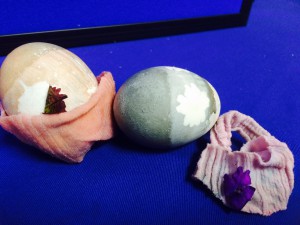
Use leaves or flowers to make interesting prints on your eggs.
Cool effects after cooking/dyeing:
- Sprinkle with salt while still wet and see what pattern emerges!
- For a mottled egg, rub/pat it with paper towel as soon as you remove it from the dye
- Draw with markers when your egg is dry
- To make your eggs gleam, rub vegetable oil on egg after cooled and dried.
These and other activities are part of 4-H, one of the nation’s most diverse organizations. 4-H includes people from all economic, racial, social, political, and geographic categories. There are no barriers to participation by any young person. Participants are given the opportunity to engage in activities that hold their personal interest, while being guided by caring and trained adult volunteers. For more information about joining 4-H as a youth or volunteer, contact your local UF/IFAS Extension Office or visit http://florida4h.org.
by Heather Kent | Mar 20, 2015

Florida 4-H Recognition Model
Recognition is a basic human need and can help build positive self esteem if handled in the right way and is an important part of the Florida 4-H Program. Whitney Cherry and Karen Miliffe shared tips for club leaders on showing recognition in 4-H clubs during the March Make a Difference Monday session earlier this month. If you missed it, you can view the recorded session at http://florida4h.org/madmondays.
Recognition is more meaningful when it occurs soon after it is earned and is related to a specific task. It can take multiple forms– appropriate recognition varies depending on age, past experience, family lifestyle, community and cultural heritage. Recognition motivates people to excel and take risks and in 4-H, it is the acknowledgement and affirmation of personal growth of an individual or group (such as a club). Awards are simply the things we give people or groups to symbolize our recognition of their accomplishments or effort.
The Florida 4-H Recognition Model includes five types of accomplishments or goals. The five types of accomplishments that 4-H measurers for recognition are:
- Participation in educational experiences (certificates, t-shirts, participation ribbons). The requirements for recognition for participation in a 4-H event are well publicized and easy to achieve. These types of recognition can be earned many times and are usually not expensive, but valued.
- Progress toward self-set goals. It is important for youth to learn to set goals and work towards them. 4-H project books are one way that we provide feedback on self-set goals. The club annual program is a tool for setting the collective goals of the club. As volunteers, we can assist youth with this by reviewing their goals frequently during the 4-H year, identifying what they have accomplished so far and helping them determine their next steps toward a goal.
- Achieving standards of excellence. In 4-H standards are used in two ways:
- Standards are established by subject matter and youth development specialists to provide a basis for young people to plan and work toward their goals
- Professional staff and /or volunteers and young people work together to establish standards– such as dress code at 4-H University, expectations of 4-Hers in club meetings, desired behavior at 4-H events/ camp
- Excelling in peer competition (judging contests, speaking contests, exhibits, animal exhibits and shows, portfolios, project book contests). Competition has long been a component in the 4-H program. 4-H strives to make competition an educational process and an opportunity to teach youth life skills. Peer competition is competing against one another’s peers. Numerous competition exist form the local club level, county, district, state, regional and national. 4-H also provides opportunities for clubs to compete against other clubs with the Club Standards of Excellence and Community Pride programs. Keep in mind that competition is not suitable for all ages (members 5-7 years old) and competition rules and procedures should be clear.
- Excelling in cooperation within a group (team or club awards or media recognition for service projects). From the beginning 4-H has encouraged young people to work together to learn. Cooperation engages young people in group experiences that are interdependent– face-to-face interactions, individual and group responsibility, group skills development. Cooperation involves everyone in the group and uses mutually agreed upon goals.
Recognition is a significant incentive to further learning. When properly used, it inspires young people to belong. Through caring adults and peers, in an inclusive and safe environment, recognition helps meets the needs of young people. Youth become and stay active in 4-H because they benefit. 4-H provides many opportunities for volunteers to make a difference in the lives of young people. If every young person could step into 4-H, imagine all the resourceful problem solvers, skilled workers, and capable leaders they’d become. That future is in our reach if we all lend our time and talents to guide the young people who will create it. Make the investment of a lifetime- become a 4-H volunteer, and inspire the next generation!
by Heather Kent | Mar 6, 2015
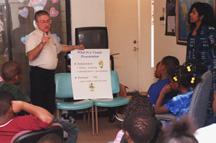 Have you ever attended a meeting for the first time and felt a little out of place? Do you remember that nervous feeling; the pit in your stomach of not knowing anyone, not sure if you belonged? Creating a welcoming environment in 4-H clubs and events helps members and volunteers have a sense of belonging. A sense of belonging is one of the Essential Elements of Positive Youth Development. Last month, Georgene Bender and Jon Mayer shared ideas for creating a welcoming environment in your 4-H club during our February Make a Difference Monday session.
Have you ever attended a meeting for the first time and felt a little out of place? Do you remember that nervous feeling; the pit in your stomach of not knowing anyone, not sure if you belonged? Creating a welcoming environment in 4-H clubs and events helps members and volunteers have a sense of belonging. A sense of belonging is one of the Essential Elements of Positive Youth Development. Last month, Georgene Bender and Jon Mayer shared ideas for creating a welcoming environment in your 4-H club during our February Make a Difference Monday session.
1. Welcome new members– have a welcome committee for your club. This committee can be a group of members or even a 4-H family that is willing to come to the meeting early to welcome any new members. They could even prepare a welcome packet with 4-H enrollment information, club brochure, calendar, 4-H pen or pencil, or even a club t-shirt. You can ask your 4-H agent for some ideas or items to include in the welcome packet. There are many inexpensive “4-H trinkets” for $1.00 or less available at the 4-H Mall. Assigning 4-H families to mentor new 4-H families is also a great way to mentor and orient new members.
- Plan “get acquainted games”- it’s difficult to feel comfortable in a group when you don’t know people well. Leading get acquainted activities during club meetings (especially at the beginning of the club year) will help establish a friendlier club environment. Ice breakers, get acquainted games, or even roll calls that ask questions about member’s interests (answer roll by making the sound of your favorite animal) can help members get to know each other better.
- Encourage engagement– a great way to get new members involved is to use the 4-H Clover worksheet to help plan the club year. If the member joins after the club planning meeting, get them involved in a committee. Smaller committees are less intimidating and can help new members feel like they belong and have something to contribute.
What will you do this year to help make new members feel welcome? Leave us a comment below! To learn more about creating welcoming environments in 4-H clubs, you can view the full, 1-hour workshop online at http://florida4h.org/madmondays.
 Research shows that 20-40% of children are bullied in some way. Whether bullying is verbal, physical, or done online it is a very real problem that can happen in any school, even among young school-age children. A safe and secure environment is key for the Essential Element of Belonging, one of the foundations of 4-H positive youth development. Being educated about what bullying is, knowing how to spot the signs of bullying, and learning what to do if your child is affected by this behavior can help parents address bullying if and when it happens.
Research shows that 20-40% of children are bullied in some way. Whether bullying is verbal, physical, or done online it is a very real problem that can happen in any school, even among young school-age children. A safe and secure environment is key for the Essential Element of Belonging, one of the foundations of 4-H positive youth development. Being educated about what bullying is, knowing how to spot the signs of bullying, and learning what to do if your child is affected by this behavior can help parents address bullying if and when it happens.






